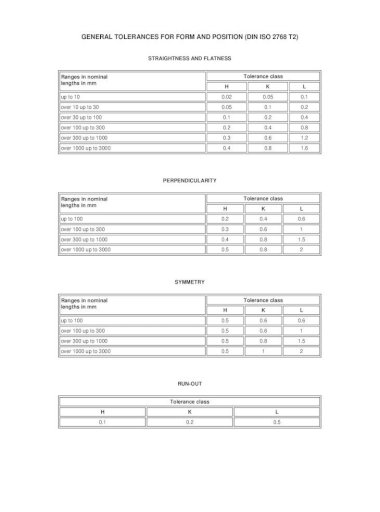

This part is intended to simplify drawing indications and specifies general tolerances in four tolerance classes. Part 1: Tolerances for linear and angular dimensions without individual tolerance indications ISO 2768 consists of the following parts, under the general title General tolerances: This first edition of ISO 2768-1, together with ISO 2768-2 : 1989, cancel and replace ISO 2768 : 1973. International Standard ISO 2768-1 was prepared by Technical Committee ISO/TC 3, Limits and fits. They are approved in accordance with ISO procedures requiring at least 75% approval by the member bodies voting. Symmetry (Position for ISO G&T Standard not-ASME or ANSI GD&T) Ranges in nominal lengths in mmĭraft International Standards adopted by the technical committees are circulated to the member bodies for approval before their acceptance as International Standards by the ISO Council. Perpendicularity Ranges in nominal lengths in mm Straightness and Flatness Ranges in nominal lengths in mm Tolerance class designation (description)Įxternal Radius and Chamfer Heights Permissible deviations in mm for ranges in nominal lengthsĪngular Dimensions Permissible deviations in degrees and minutes for ranges in nominal lengths Linear Dimensions Permissible deviations in mm for ranges in nominal lengths ISO 2768 is mainly for parts that are manufactured by way of machining or removal of materials. ISO 2768 and derivative geometrical tolerance standards are intended to simplify drawing specifications for mechanical tolerances. Variations on dimensions without tolerance values are according to ” ISO 2768″. Technical drawings - Fundamental tolerancing principle. Geometrical tolerances for features without individual tolerance indications. ISO 2768-2 : 1989, General tolerances - Part 2: And for machined components ISO 2768–fh can be used. For example : for sheet metal parts ISO 2768–mk is used.

Tolerance class is defined as per design requirements and manufacturing capability. General tolerance ISO 2768 does not specify where to use these tolerances. ISO collaborates closely with the International Electrotechnical Commission (IEC) on all matters of electrotechnical standardization. International organizations, governmental and non-governmental, in liaison with ISO, also take part in the work. Variations on dimensions without tolerance values are according to ISO 2768, all tolerance limits are given in mm. ISO 2768 and derivative geometrical tolerance standards ISO 2768–mk and ISO 2768–fh are intended to simplify drawing specifications for mechanical tolerances.


 0 kommentar(er)
0 kommentar(er)
